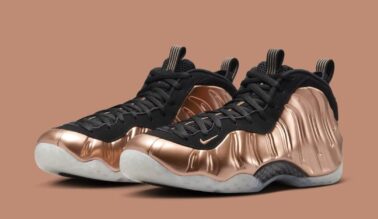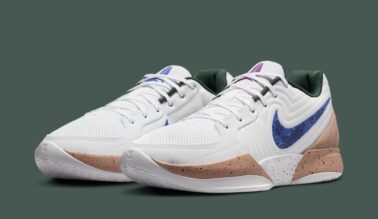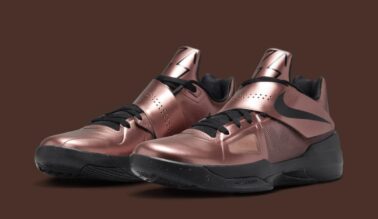This post may contain affiliate links. Please read our disclosure policy.
Although there seems to be no solution to the current NBA lockout, it will not stop the basketball sector of brands from releasing high-quality, performance-driven basketball shoes. Following the Nike Zoom Hyperfuse 2011 Performance Review we posted two weeks ago, we now enlighten you with our review of the Nike Basketball darling Zoom Hyperdunk 2011. This Blake Griffin endorsed sneaker is the third installment of Nike’s Hyperdunk series.
Is this shoe an upgrade from its predecessors? What special, basketball-ready attributes did Nike incorporate? Check out our Nike Zoom Hyperdunk 2011 performance review to find out the answers to these questions and more.
RELATED: Nike Zoom Hyperdunk Officially Unveiled | Performance Review: Nike Zoom Hyperfuse 2011 | Weekly Wallpaper: Nike Zoom Hyperdunk 2011 Blake Griffin 10.0 PE | Performance Review: Nike Hyperdunk 2010
Breathability: The Nike Zoom Hyperdunk 2011’s breathability factor is a direct correlation with Nike’s ever-evolving Flywire technology. The original Hyperdunk and the Hyperdunk 2010 ranked very low in breathability because the extreme lockdown support provided little to no wiggle room for the foot (a good thing or bad thing depending on the wearer’s preference). Yet, the newly updated, seamlessly blended mesh composite upper acts as an open-hole breathable source for the foot in the same vein as the Nike Zoom Hyperfuse 2011. There is a very obvious difference when playing in the Hyperdunk 2011 as opposed to its predecessors in regards to breathability. There is much more ventilation provided for the foot without jeopardizing the lockdown support that has come to be an expectation in the Hyperdunk series. It is definitely an upgrade from the synthetic skinwire seen on the Hyperdunk 2010, which was not a breathable material at all.
Lockdown: There are no automatic fastening systems on this shoe nor the Nike MAG 2011, but the Hyperdunk 2011 bears a very clamped down, clinching fit. As stated above, we expected the Hyperdunk 2011 to feature an unmatched level of lockdown support seeing that the Hyperdunk and Hyperdunk 2011 possessed the same. This is one of the lone attributes Nike should incorporate into the Hyperdunk series as long as it is around. It is arguably the best characteristic of this series and is a seemingly innate trait. Once lacing this shoe, your foot feels extremely secure and plays as one with the shoe. The Hyperdunk 2011 may own more lockdown than its predecessors because of the aforementioned mesh composite upper. You can lace this shoe up, and it will reach its full potential in regards to lockdown whereas the Hyperdunk 2010’s lacing structure sort of restrained you from getting a full sense of closeness to the foot at times.
Traction: Much like the lockdown support attribute, the traction element of the Hyperdunk series is seemingly the same between all three designs. The solid rubber outsole, with herringbone traction pattern, receives no complaints from us. It is excellent for indoor and outdoor play and will provide the wearer with extreme grip on either surface. The only difference from the Hyperdunk 2011 and the previous creations is the latest model features different aesthetics. Specifically, you can actually see the Zoom Air bags through transparent windows in the heel and forefoot. Nevertheless, the performance capability of the traction is great to say the least.
Cushioning: The Nike Zoom Hyperdunk 2011’s midsole is very soft and highly cushioned, which is an attribute every wearer will welcome. The Zoom bags, placed in a Phylon midsole, act as a responsive surface allowing the foot to feel very secure and balanced from heel to toe. Zoom Air was a welcomed change from the Hyperdunk to the Hyperdunk 2010, therefore, we feel as if Nike should have carried this attributed onto the Hyperdunk 2011 anyway.
Responsiveness: Here is where one of the Nike Zoom Hyperdunk 2011’s new and very important characteristics comes into play. If you recall, last year’s Hyperdunk 2010 featured an enlarged shank at the bottom of the outsole for responsiveness. However, that has been replaced with a unique 3-D shaped, glass reinforced composite shank for an even higher level of responsiveness in the Hyperdunk 2011. The large shank seen on the Hyperdunk 2010 was a bit flat and wasn’t as bouncy/springy as other shoes on the market. You can feel an obvious difference in the Hyperdunk 2011. When landing on the surface from a rebound, contesting a shot or any other instance that requires jumping in basketball, the Hyperdunk 2011’s glass reinforced composite shank aids in decreasing the response time for a quick, second jump. There are a few sneakers out there that require you to gather yourself before reacting, but the springy shank gives you a sense of quick reaction/response time, so that you will not lose any seconds.
Support: Sure, the Hyperdunk 2011 ranks higher than its predecessors in responsiveness and breathability, but we were not as confident, support-wise, while playing in the Hyperdunk 2011. One particular element that sticks out is the tongue construction. We feel as if the original Hyperdunk still possesses the better tongue support and feel thanks to the padding. The last two creations, the Hyperdunk 2010 and this year’s Hyperdunk 2011, feature an extremely thin tongue, which gives way to a little discomfort throughout the entire wear of the shoe. It’s not enough discomfort to totally abandon the shoe, but this particular focus in the wear of the shoe could be improved. On the bright side, the amplified collar is extremely flexible. For those of you who still have an apprehensive mind about low-top basketball sneakers, the Hyperdunk 2011 owns a nice, over-the-ankle construction all while providing a low-profile feel similar to that incorporated into Kobe Bryant’s latest footwear designs. The overall shape of the shoe is very supportive, namely the midsole (Zoom units in heel and forefoot).
Durability: The durability factor of the Nike Hyperdunk 2011 is still up in the air. When you think of all of the weight-shedding (11.5 ounces) Nike did with this creation, it makes you question what they gave up in order to make a very lightweight sneaker. Yet, with that said, the Hyperdunk and the Hyperdunk 2010 have held up nicely since their inceptions onto the market. While the Nike Zoom Hyperdunk 2011’s composite mesh upper is great for breathability, we wonder how long this construction will last with the wear and tear of a regular basketball season.
Overall: While the three-sneaker Nike Hyperdunk series has revealed pro and cons in each model, you cannot deny the overall performance of all three models. The Hyperdunk 2011 showcases Nike’s efforts to improve on Flywire and the ultimate, sleek design that caters to all basketball players no matter what size, shape or position. Breathability and responsiveness are two categories that place the Hyperdunk 2011 above its predecessors in addition to the very attributes that make the Hyperdunk series so coveted (lockdown support, traction). The Nike Zoom Hyperdunk 2011 is a great buy for those who long for the must-have advantages that a performance-driven shoe can offer: lockdown, breathability, cushioning and responsiveness.
The Nike Zoom Hyperdunk 2011 is now available at Nike retailers for $125.



